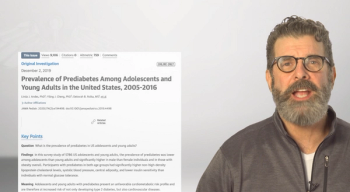
A recent Danish study examines the connection between body mass index (BMI) and the risk of developing hidradenitis suppurativa in adulthood.


A recent Danish study examines the connection between body mass index (BMI) and the risk of developing hidradenitis suppurativa in adulthood.

For Contemporary Pediatrics, Dr Bobby Lazarra discusses a survey study published in JAMA Pediatrics that looks at the prevalence of prediabetes in the pediatric population of the United States.

A new study connects an asthma diagnosis to type 1 diabetes (T1D) development later in life but also shows that the opposite may not be true.

A study of hemoglobin A1c (HbA1c) levels that compared levels in normal-weight and obese middle schoolers found that overall distribution of HbA1c was similar in the 2 groups and that the adult-defined cutoff was seen in 2% of normal-weight youth.

Clinicians may be able to identify patients at the highest risk of developing type 1 diabetes with a simple saliva test.

Thyroid disorders present with overt symptoms or insidiously with few signs of disease. Here’s how pediatricians can identify and effectively treat children with thyroid disease or refer patients for further evaluation.

Poorer educational outcomes may need to be added to the list of the potential outcomes for children who have type 1 diabetes.

Quality and quantity go hand-in-hand when it comes to surgical outcomes, according to a new report highlighting positive outcomes at high-volume thyroid surgery centers.

Contemporary Pediatrics sits down exclusively with Philippe F. Backeljauw, MD, a pediatric endocrinologist to discuss the one key condition for which he believes community pediatricians should be especially aware-Turner syndrome.

Children who are overweight or obese are potentially at risk for developing diabetes, but there’s more to identifying prediabetes than just obesity.

With planning, transitioning teenagers from pediatric care to adult care for their diabetes doesn’t have to be stressful for either patient or provider.

ABSTRACT: Polycystic ovary syndrome (PCOS) is the most common endocrinopathy among females of reproductive age. In adolescents, PCOS often manifests with irregular menses, hirsutism, and acne. Despite general agreement that the metabolic derangements of PCOS arise during puberty, the condition is diagnosed more often in adults than in adolescents. Treatment is focused on weight loss, menstrual cycle regulation, and amelioration of physical symptoms. Acute symptoms can be managed with combination oral contraceptives and antiandrogens and potentially with insulin-sensitizing drugs. Lifestyle modification, especially in overweight patients, can reduce symptoms and help prevent long-term health consequences.

During my training, most pediatric endocrinologists were using the "70/30 rule" or the "rule of fifths" to determine the insulin dosage for patients with new-onset diabetes. Now that I am in practice, I have heard that carbohydrate counting is a more accurate method of determining a child's insulin needs.

Polycystic ovary syndrome (PCOS) isthe most common endocrinopathyamong reproductive-aged women; theprevalence is about 5% to 10%.

What should primary care pediatricians do--and what should we not do--when we encounter a patient with newly diagnosed diabetes?

What are the indications for use of an insulin pump in veryyoung children (infants and preschoolers)?

As our children are becoming fatter, diabetes is becoming more common. Diabetic ketoacidosis (DKA) can lead to cerebral edema, a complication unique to the pediatric population and a common cause of death in this young group.

A 45-day-old boy was referred for evaluation of persistent hyponatremia and hyperkalemia. On the 9th day of the boy's life, his serum potassium level was elevated (8 mEq/L) and on the 12th day, his serum sodium level was low (131 mEq/L). Supplementation with sodium chloride was initiated.

Key words: type 2 diabetes melllitus, childhood obesity

Consultations & Comments: